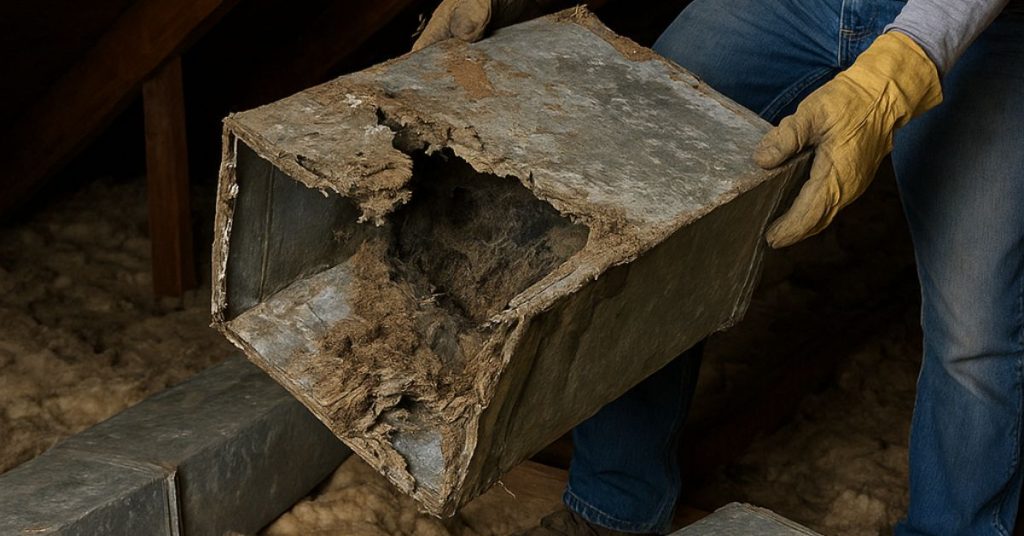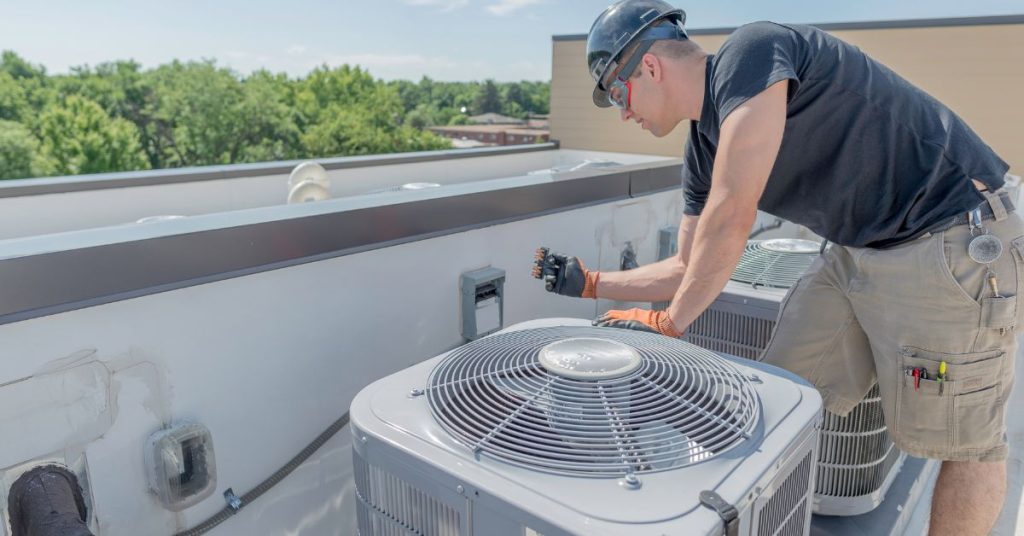Knowing when to replace vs repair ductwork depends on factors like air leaks, mold, or extensive damage. Minor issues can be sealed or repaired, but replacement is best for old, inefficient, or deteriorated systems.
Key Takeaways:
- Inspect ducts for leaks or visible damage.
- Repair minor wear; replace aging systems.
- Ensure efficiency and indoor air quality.
In the world of HVAC systems, ductwork is the silent backbone of your heating and cooling efficiency. Poorly functioning ducts can compromise indoor air quality, spike your energy bills, and reduce system longevity. Understanding when to repair vs replace ductwork is critical for maintaining optimal comfort and performance in your home or commercial space. In this guide, we provide expert insights to help you make informed decisions.
What is Ductwork and Why It Matters
Ductwork is the system of metal or flexible tubes that circulates heated or cooled air from your HVAC unit throughout your home or building. It ensures every room receives balanced airflow for consistent comfort. When properly designed, sealed, and insulated, ductwork helps your HVAC system perform efficiently, maintaining stable indoor temperatures and improving air circulation across all areas.
When ductwork becomes leaky or filled with dust and debris, it can lead to poor air quality and inefficient airflow. Regular inspection and cleaning help prevent the health hazards of dirty air ducts you can avoid, such as allergies, respiratory irritation, and the spread of airborne contaminants. Keeping your ductwork clean and well-maintained not only enhances system performance but also protects your family’s well-being and overall indoor comfort.
Common Signs of Ductwork Problems
Knowing the warning signs of ductwork deterioration is essential. These red flags indicate it’s time to assess whether to repair or replace your ducts:
- Inconsistent temperatures in different rooms
- Unusually high energy bills
- Dust accumulation despite regular cleaning
- Whistling or rattling noises from vents
- Moldy or musty smells coming from vents
- Visible holes, cracks, or disconnected segments
When Is Ductwork Repair the Best Option?
In many cases, repairing ductwork can restore performance without the need for a complete overhaul. Choose repair when:
1. Minor Air Leaks Are Present
If inspection reveals small gaps or loose joints, professional duct sealing or mastic application can restore efficiency. According to ENERGY STAR, sealing ducts can improve HVAC efficiency by up to 20%.
2. Sections Have Become Loose or Disconnected
Duct segments may become dislodged due to vibration, poor installation, or age. These can typically be re-secured and supported, ensuring optimal airflow without full replacement.
3. Ducts Are Less Than 15 Years Old
If your ductwork is relatively new and the material is still in good shape, targeted repairs are often more cost-effective. Modern systems are typically built with flexible or rigid metal ducts that can last 20–25 years when maintained properly.
4. You’re Facing Localized Damage
Damage from pests or moisture intrusion in one area doesn’t necessarily mean a total system failure. Localized repairs can be completed quickly and affordably.
When Should Ductwork Be Replaced?

There are times when repairs are no longer enough. Here are key scenarios when full duct replacement is the smarter investment:
1. Your Ductwork is Over 20 Years Old
Aging ductwork begins to deteriorate structurally, leading to air leaks, insulation failure, and reduced airflow. Replacing outdated ducts can improve system efficiency by up to 40%.
2. Visible Damage is Widespread
If inspections reveal crushed, corroded, or collapsed sections in multiple areas, repairs will be both ineffective and inefficient. A complete replacement ensures air can flow freely throughout the system.
3. Mold or Contamination Issues Exist
Mold in ducts is a serious health hazard. If mold, mildew, or rodent infestations are deeply embedded, cleaning may not be enough. Replacing contaminated ducts is essential to protect indoor air quality.
4. You’re Remodeling or Upgrading HVAC Equipment
If you’re expanding your home, remodeling, or upgrading to a high-efficiency HVAC system, replacing ductwork may be necessary to match airflow requirements and avoid performance issues.
5. Energy Loss is Significant
If energy audits show that your ducts are losing more than 30% of conditioned air, it’s likely more cost-effective to replace the ductwork than continue patching leaks.
Types of Ductwork: Which Should You Choose?
When replacing your ductwork, selecting the right material and configuration is critical. Here are the main options:
1. Flexible Ducts
Made of plastic over a metal wire coil, these are easy to install in tight spaces. They’re ideal for short runs but must be properly supported to prevent sagging.
2. Sheet Metal Ducts
Durable and long-lasting, galvanized steel or aluminum ducts are resistant to mold and pests. They offer superior airflow and are often recommended for complete replacements.
3. Fiberglass-Lined Ducts
These offer sound dampening and thermal insulation but can harbor dust and mold if not properly maintained. They are not ideal for high-humidity areas.
Cost Considerations: Repair vs Replace
The cost of ductwork repair vs replacement varies depending on multiple factors:
Service | Average Cost |
Minor Repairs (sealing, patching) | $300 – $700 |
Duct Cleaning | $350 – $600 |
Full Duct Replacement (standard home) | $2,000 – $6,000 |
Custom or Commercial Duct Replacement | $6,000 – $12,000+ |
Pro Tip: Always get a professional duct system condition evaluation before committing to repairs or replacement. A detailed assessment will identify hidden issues and ensure the most cost-effective decision.
Energy Efficiency and ROI
Replacing outdated or leaking ductwork doesn’t just improve comfort—it can lead to substantial energy savings over time. Homes with new, well-designed ductwork experience:
- Lower utility bills
- Improved system lifespan
- Better air circulation
- Increased home value
According to the U.S. Department of Energy, homes lose 20%–30% of air through leaky ducts. Sealing or replacing them can translate into hundreds of dollars saved annually, and incorporating regular HVAC maintenance ensures these benefits last longer.
Professional vs DIY Ductwork Repair
While sealing small leaks using foil-backed tape or mastic is a manageable DIY job, more extensive work—especially full replacements—should always be done by licensed HVAC professionals. This ensures:
- Proper sizing and configuration
- Compliance with local building codes
- Safe handling of insulation materials
- Accurate airflow testing and balancing
Improper repairs can lead to restricted airflow, increased strain on HVAC components, and even fire hazards if ducts are near heat sources.
Maintenance Tips to Extend Ductwork Life
To avoid premature replacement, routine maintenance is essential. Here are best practices to maximize duct longevity:
- Schedule annual HVAC inspections
- Seal ducts at the first sign of air leaks
- Replace air filters every 1–3 months
- Keep vents unobstructed
- Ensure proper insulation in attics and crawlspaces
- Watch for pest intrusion or water damage regularly
Preventive care not only delays the need for duct replacement but also improves indoor comfort and air quality year-round.

Conclusion: Repair or Replace? Make the Right Call
The decision to repair or replace ductwork depends on age, condition, performance, and contamination levels. Minor issues can be resolved with targeted repairs, but old or damaged systems will benefit greatly from full replacement. Investing in modern, efficient ductwork ensures optimal HVAC performance, lower energy costs, and healthier indoor air.
For a professional assessment, trust 5 Star Air to handle your duct needs. Whether you require expert duct removal & installation or targeted repairs, their team can evaluate your system and recommend the best solution for long-lasting comfort and efficiency.
